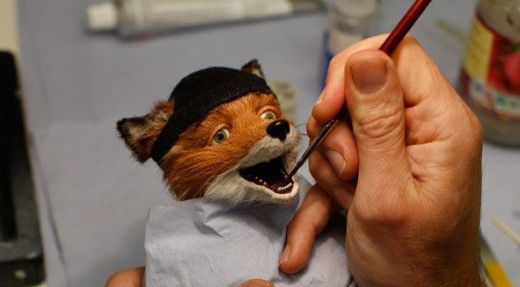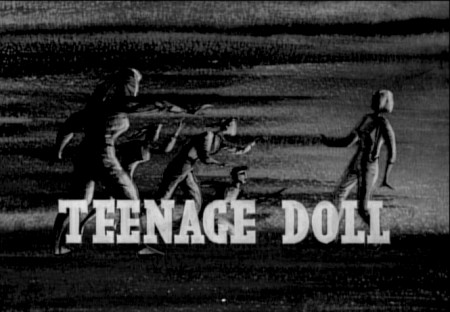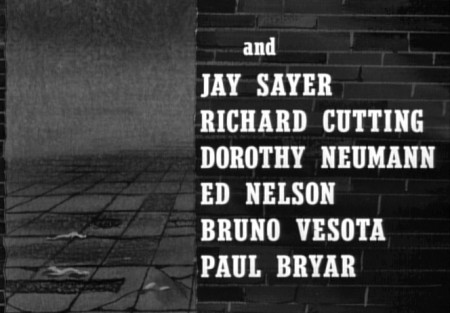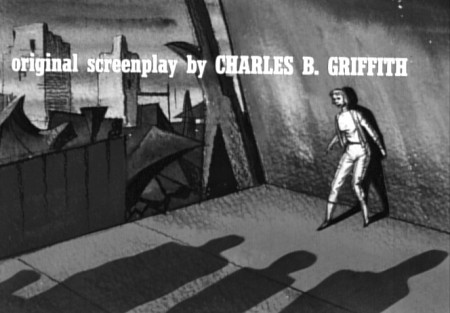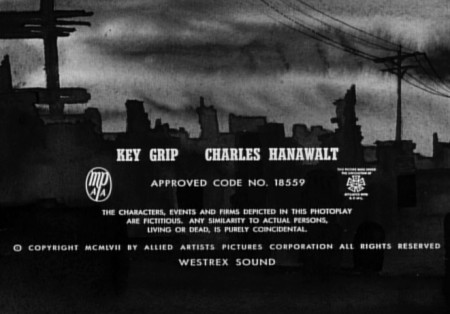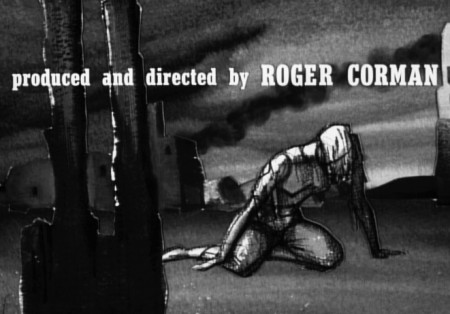Category ArchiveCommentary
Commentary 03 Nov 2009 08:40 am
Lmtd anim8n
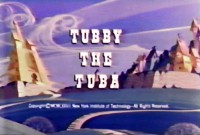 - There was a quiet day at the studio during the production of Tubby the Tuba. Johnny Gentilella and I were left alone for a few minutes during our lunch break. I took the opportunity to ask him a question I’d just about rehearsed asking for months prior.
- There was a quiet day at the studio during the production of Tubby the Tuba. Johnny Gentilella and I were left alone for a few minutes during our lunch break. I took the opportunity to ask him a question I’d just about rehearsed asking for months prior.
While working together previously on Letterman for the Hubleys, I was the person who assisted all of the 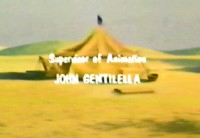 animators and inked all of the drawings. This was for 20 mins. of animation done in 2½ months in 1973. As a relative newcomer to the business, I studied and absorbed every drawing and exposure sheet that came my way. I was working with the work of some brilliant animators.
animators and inked all of the drawings. This was for 20 mins. of animation done in 2½ months in 1973. As a relative newcomer to the business, I studied and absorbed every drawing and exposure sheet that came my way. I was working with the work of some brilliant animators.
Essentially, in the kindest possible way, I asked Johnny Gent why a scene he did for Tubby at a podium matched a scene he did of Spellbinder, from 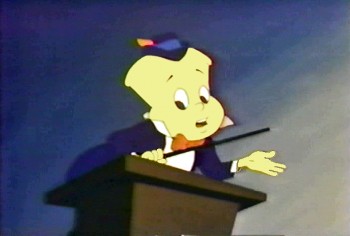 Letterman, at a podium almost drawing for drawing. The exact same scene with two different characters for two different films.
Letterman, at a podium almost drawing for drawing. The exact same scene with two different characters for two different films.
Johnny explained that in these days of low budgets and tight schedules the animator took the brunt of the responsibility for the movement despite the fact that there were no pencil tests to check on their scenes. If it didn’t work, the animator usually lost the job. So, said Johnny, he had to fall back on what he knew worked, use all the tricks at his disposal and make it acceptable to his client – the film’s director.
There wasn’t the opportunity for him to play around or experiment. He used what he knew. I understood his logic and said so.
I remember, a couple of months later, telling Tissa David this story. She responded that Johnny was so lucky to have such a memory. She wished she could remember what she’d done from day to day so that she could repeat it. But no. She had to come out drawing, experimenting and creating every scene from scratch.
While having coffee with John Dilworth last week we got into a conversation over something I’d posted on my blog. The subject started with the idea that humans do little motion in most of their activities.
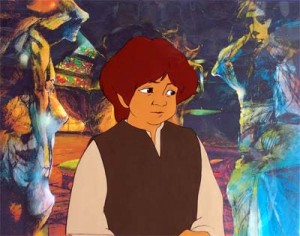 Ralph Bakshi . . . said that humans stand still most of the time, but that if an animated character would stay still, it wouldn’t be acceptable. It would look like poor limited animation. It’s a problem good animators enjoy solving.
Ralph Bakshi . . . said that humans stand still most of the time, but that if an animated character would stay still, it wouldn’t be acceptable. It would look like poor limited animation. It’s a problem good animators enjoy solving.
This led to our discussing what kind of animation is actually out there and how limited or generic or poor the movement. Then John said something that stopped my brain in its tracks. He said that there’s also the animator who doesn’t do the movement that he actually imagines for the character but limits it. The reasons are many: money, speed, laziness, whatever. The acting is bad because the client and/or public will accept the cheaper movement, so why do more.
I had to admit that this is probably true for 99% of all bad animation out there. Assuming the animator can do the movement properly, there’s the need to keep the money flowing, get the job in & out, or, in some cases, do all you need do to get the point across. It’s a cynical thought, but it’s probably also an accurate one for the reality of the world of the animator.
Animation’s come a long way since those days in 1973 when I worked at Tubby the Tuba. Now there are computers to “make our jobs easier.”
Programs like Flash not only encourage limited animation but demand it. As a matter of fact most computer-drawn imagery is more easily designed for limited animation. Though I’m writing and thinking, principally, about 2D – flat art, I expect some of the same problems exit for cg animation. Animated features done “traditionally” aren’t breaking much new ground either.
Now, I gaze at my navel wondering how much work I’m doing is in any way “daring”, and thinking that I have to start getting serious. I think we all do.
Articles on Animation &Commentary 30 Oct 2009 08:57 am
Live Action Directors Animate
 - The New York Times reported that Jonathan Demme is planning to make an animated feature of the book, Zeitoun by Dave Eggars.
- The New York Times reported that Jonathan Demme is planning to make an animated feature of the book, Zeitoun by Dave Eggars.
The book is about the reconstruction efforts taking place in New Orleans done since the Katrina disaster effort.
Apparently Demme was taken by the illustration on the cover of the book and immediately saw it as animation. He’s quoted as saying, “I was staring at the book, and there’s this wonderful line drawing on the cover, the character of Zeitoun in his canoe, paddling through a submerged neighborhood. And I suddenly imagined, What if we could do an animated film and visualize the experiences of the Zeitoun family and all of New Orleans?â€
They haven’t decided what the style of the film will look like, but Demme favors a hand-drawn style for the film.
The New Yorker magazine has a profile of Wes Anderson. (I’ve given the link to the magazine, but it’s open only to subscribers.) Anderson is the director of Rushmore, The Royal Tenanbaums and The Darjeeling Limited. He’s also the director of the upcoming puppet film, The Fantastic Mr. Fox, which was based on the Roald Dahl book.
The article opens and closes with a couple of columns about the animated film, but primarily focuses on Anderson’s bio and career.
In reading the article, a short bit popped out at me.
- For stop-motion animation, the actors’ voices must be recorded in advance, so that the figurines’ mouths can be moved in synch with the dialogue. The recording is usually done in a sound studio. Anderson did things differently. In the fall of 2007, he took a handful of actors, including (George) Clooney and (Bill) Murray, to a friend’s farm in Connecticut. In order to make the voices and the film’s soundscape realistic, Anderson had his actors perform the motions—running, digging, and climbing—that the figurines would perform; he recorded the exterior scenes in the fields, and the interiors in the farmhouse.
Anderson’s direction, with its protracted long takes and tight closeups, treats the figurines like actors, emphasizing their “performances.” The production designer, Nelson Lowry, told me that Anderson’s approach to animation was “very counterintuitive.” He made, Lowry added, “unconventional choices, such as keeping characters still. Usually, animators keep characters constantly in motion; if they re doing nothing, they blink.” Lowry calls Anderson’s expressive stillness a “compression of character.”
Let me repeat part of that last sentence: “Usually, animators keep characters constantly in motion; if they re doing nothing, they blink.”
This is the notion that live-action directors (probably all live action film makers) have of acting in animation. And I can’t argue too much with that. This is a good deal of acting in animated films: keep it moving, keep it moving, keep it moving regardless of the thought the characters are supposed to be having.
However, Anderson’s notion of acting, “keep it still” isn’t acting either. I remember Ralph Bakshi giving a talk after making Lord of the Rings, just prior to a screening. He said that humans stand still most of the time, but that if an animated character would sit still, it wouldn’t be acceptable. It would look like poor limited animation. It’s a problem good animators enjoy solving.
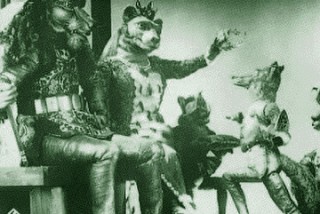 Unfortunately, what I’ve seen of The Fantastic Mr. Fox looks like poor limited animation in puppets – a bit like those old Rankin-Bass episodes of Pinocchio. The difference is that the characters, here, are covered with fur making them look more like an early Starevich film. (Regardless, I like Anderson’s films so I’m still looking forward to seeing this – however it’s animated.)
Unfortunately, what I’ve seen of The Fantastic Mr. Fox looks like poor limited animation in puppets – a bit like those old Rankin-Bass episodes of Pinocchio. The difference is that the characters, here, are covered with fur making them look more like an early Starevich film. (Regardless, I like Anderson’s films so I’m still looking forward to seeing this – however it’s animated.)
Getting back to some real animation, Hans Perk (in case you didn’t know) has been posting the drafts from Snow White. What a resource his site is! Many thanks, Hans.
Commentary 24 Oct 2009 09:03 am
2D Art?/AstroBoy/Plymptoon/
- I recently received this email via Facebook:
- Hi
I’m a self-taught animator from Colombia, South America.
Today, I’ve found out that John K’s blog is going private. I think he was tired of some comments, or dissappointed by the reaction to some of his posts when he speaks his heart out. Well, it is a shame and I hope he’ll make it public again, or at least that he invites me to join.
Anyway, sometimes one takes for granted things, and your blog is one of my daily visits. It contains so much information, and I just want to thank you for sharing this knowledge, and to take your time to keep it active.
Well, if you wanna see some of the use I made with your info, check my practice blog: here. Also you can check a short film I made some time ago: here.
Bye and thanks again ![]()
Hasta Luego
I receive similar letters often as a result of my blog. It’s humbling to get them, but, at the same time, it’s part of the reason I keep doing this so enthusiastically. I enjoy sharing the bits and pieces that come my way, and I truly want to see 2D animation continue on a high road. Only by keeping the word out there and sharing the knowledge of those I revere can the stream stay alive.
I’m not quite sure why John K decided to make his blog Private, but I have no plans to follow suit. It is nice, once in a while, to hear that others enjoy it as well.
- Michael Barrier has a smart piece on his site. In Lost Illusions, he writes about the artist – in our case, the animation artist – who tries to stick to his sense of value and artistic integrity, but because of the way the medium is constructed, compromises set in and become an integral part of the “art” that the artist not only develops but defends.
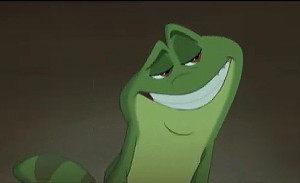 Mike’s commentary is a buildup to carefully analyze the six minute opening of The Princess and the Frog. Unfortunately, I agree wholly with what he has to say. I haven’t seen the six minute piece (apparently on the Snow White Blu-Ray disc), but I have seen various trailers. All contain scenes that are heavily affected by an unbearably unctuous frog, sarcastic and racy in the tedious way of all sitcom sensibilities. This isn’t adult; it’s just tawdry. Only 30 seconds, and I’m not sure I want to see more. But this is only a trailer, and I have to see the whole film.
Mike’s commentary is a buildup to carefully analyze the six minute opening of The Princess and the Frog. Unfortunately, I agree wholly with what he has to say. I haven’t seen the six minute piece (apparently on the Snow White Blu-Ray disc), but I have seen various trailers. All contain scenes that are heavily affected by an unbearably unctuous frog, sarcastic and racy in the tedious way of all sitcom sensibilities. This isn’t adult; it’s just tawdry. Only 30 seconds, and I’m not sure I want to see more. But this is only a trailer, and I have to see the whole film.
I will see it – how can I avoid it, how can I not support 2D animation on a large scale. I hope that The Princess and the Frog will be better than I expect, but things don’t bode well with scenes seen in the trailers.
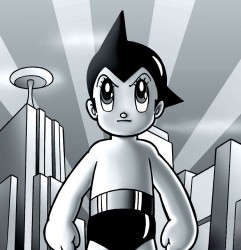 - Yesterday, this paragraph pretty much summed up the review Manohla Dargis gave to Astro Boy in the NY Times.
- Yesterday, this paragraph pretty much summed up the review Manohla Dargis gave to Astro Boy in the NY Times.
- Like a lot of movies, “Astro Boy†has been designed to function on different levels and serve different audiences, but in this case these multiple meanings and points of address have created a confusion of tone. The story’s undertow of darkness pulls you in one direction, while Astro Boy’s insistent cheerfulness, which seems more commercially motivated than personality-driven, pulls you somewhere else. This jaggedness extends to the visual design, which at times intriguingly recalls the flat, graphic style of the 1950s, yet also often looks thinly conceived, sketchy, even cheap. Somewhat more rounded than the original character, Astro Boy, meanwhile, now brings to mind the chubby mascot for the restaurant chain Big Boy. Maybe the fuller figure is part of his Americanization.
Wouldn’t it have been amazing if some industrious producer had stuck to the original look and feel of those cheap Astro Boy TV shows? 2D animation on fives and sixes with dialogue that sounded lip-synched even though it sort of worked. Cheap cartoons made to look like the high priced spread. Everything’s getting to look alike.
Is this one of those 15 eligible for the Oscar?
NYDaily News – 2 stars
NY Post – 3 stars
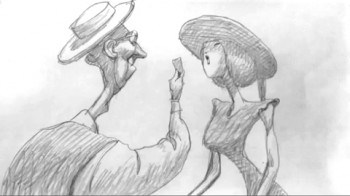 - Speaking of Independent films, Bill Plympton has a Pencil Test of his latest short, Cheatin’, available on YouTube. It’s a work still in progress so the usual disclaimers have to be attended to. However, I have to say that some of the drawing in this film is among the best I’ve seen from Bill. Very inspirational.
- Speaking of Independent films, Bill Plympton has a Pencil Test of his latest short, Cheatin’, available on YouTube. It’s a work still in progress so the usual disclaimers have to be attended to. However, I have to say that some of the drawing in this film is among the best I’ve seen from Bill. Very inspirational.
Commentary &Illustration 20 Oct 2009 07:48 am
Not Paul Julian’s Wild Teen
- Here are the scenic art that makes up the title sequence to Roger Corman’s film, Teenage Doll. I would be posting this as a Paul Julian title, as many ardent fans credit the titles. But they’re wrong, this is not the work of Julian. It’s a poor imitation.
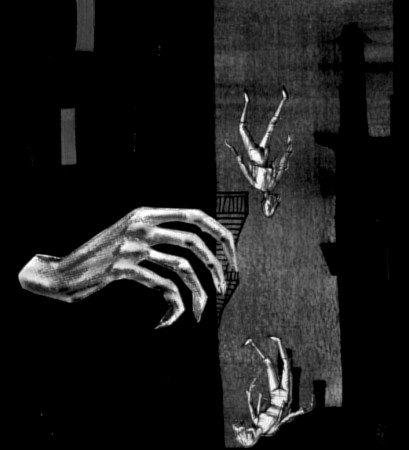
(Click any image to enlarge.)
A couple of peculiar cards set up the main title.
First a very slow pan down while hands appear and disappear.
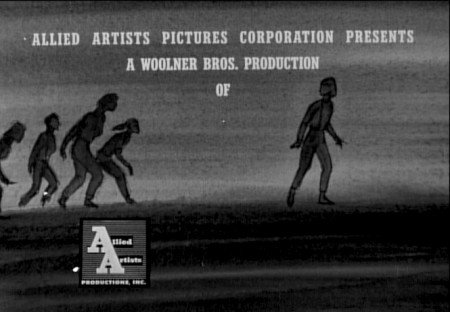
Allied Artists gets their title card – not full screen!

The camera pans across brick wall fragments
as a few names come and go.
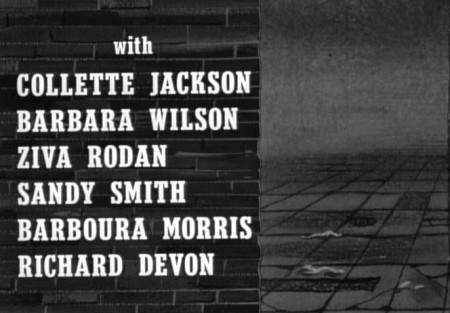
The camera makes a slight move as we go from the
title above to the title below.
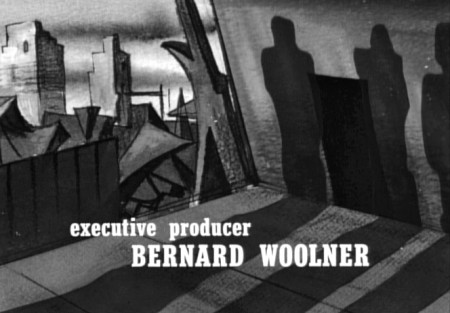
Shadows move in as type changes.

Cut to a pan as a bunch of titles fade on and off.
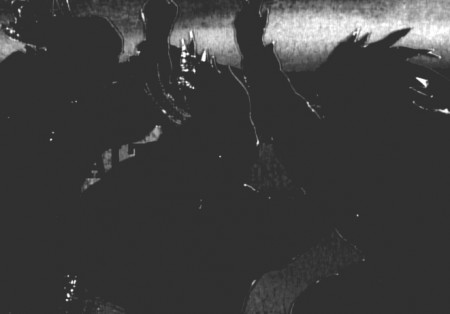
Some black cut out figures pan up and in.
They’re so shoddily produced that the lights are
shining off the edges of the card.
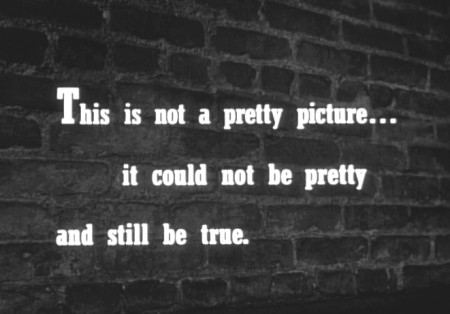
The text is printed over a photo of a brick wall.
I guess they had no left over artwork.
Obviously there are problems with this title sequence. The worst has to be seen as it moves on screen. A pathetic sense of timing has type popping on and off the screen too brieftly or held too long. The artwork looks more like some agency storyboard than actual production artwork.
This is most certainly not Paul Julian’s work. Stylistically it’s obvious, however, there’s so little professional about these titles that I know Julian couldn’t have been involved.
What I expect happened, was that he was offered the job for less than the couple of hundred dollars usually offered. He turned it down and some beginner took it to get his feet wet. Too bad.
The unfortunate part is that the designer didn’t even get a credit, so we don’t know who did it.
Commentary &Daily post 16 Oct 2009 08:15 am
Ranting/USC/Free Lancing/Updates/Rain!
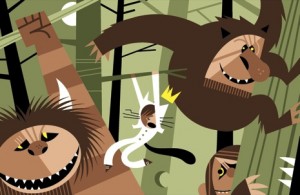 - Last night I saw Where the Wild Things Are. To be honest, I didn’t really want to go, but went just the same. Not good.
- Last night I saw Where the Wild Things Are. To be honest, I didn’t really want to go, but went just the same. Not good.
Yes, I know all the reviews I’ve seen are glowing. But I found it boring once they settled in on the island.
David Denby‘s review in the New Yorker got it right. Read it before you go; that’s the film you’ll see.
The cgi manipulated faces of the characters is excellent as are the voices. Sensational acting by James Gandolfini, Lauren Ambrose, Catherine O’Hara, Chris Cooper, Paul Dano and Forest Whitaker. All of them. And the kid, he’s good, too.
But Spike Jonze! Why do you have to tell us everything that’s going on on screen? Why do you have to overanalyze a book that has so much depth; it gives us reason to think. Do you just want to stop us from thinking? Give me the book. I don’t want this thing to sit in the unconscious memory of children watching. Give them the book. Yccch!
It’s an adult’s idea of adapting a children’s book. Repetitive, Tiresome and Boring.
___________________

- I’d be afraid to see the Jim Carrey Christmas Carol soon to come out. From the look of it, they’re throwing everything and the kitchen sink at the audience through the magic of 3D. Christmas wreaths, icicles, snow, even Jim Carrey. They all fly in our face. $5 extra, please, for the glasses and $3 extra for the aspirins to take care of the headache.
- According to a piece in The Wrap, Wes Anderson didn’t want to stay on set during the tedious two year shoot of The Fantastic Mr. Fox, so he went to Paris while the film’s “Director of Animation”, Mark Gustafson, did the heavy lifting. Footage was sent via email to Paris and back a response would come.
Anderson said, “the movie would not be the way I wanted it if I just did it the way people were accustomed to doing it.†Give that man an Oscar.
- Tomorrow at USC, the Entertainment Law and Business Conference will be held. Described as “…in-depth examinations of the newest opportunities in animation.”
Guest panelists will include:
- Robert A. Iger, president and CEO of The Walt Disney Company who will be the keynote lunchtime speaker.
The heads of four major talent agencies: Jeffrey Berg (ICM), Jim Berkus (UTA), Ari Emanuel (WME) and David O’Connor (CAA). They will participate in discussion on “The Future of Agencies.”
Tom Sito will talk on animation’s future and how it will depend on continued technical development or a refocus on storytelling and character? And what opportunities exist for creators of new media, such as animated webisodes or short-form flash animation on the Web?
Saturday, Oct. 17. The session on “New Opportunities for Animation” will begin at 9 a.m. The doors open for registration at 7:30 a.m.
For more info call USC Law’s Continuing Legal Education office at 213-743-1772 or log on to their site.
- A friend, Steve Parton sent this YouTube video about the fun of freelancing as a designer – though it’s applicable to anyone who works in this business. It’s a laugh, if you haven’t seen it as yet.
___________________
- RIchard O’Connor has been giving daily updates on the Ottawa Animation Festival, as it progresses. There’ve been two posts, to date, and if you have any interest in what’s up at this Festival, you owe it to yourself to check it out. Asterisk Animation
Day #1
Day #2
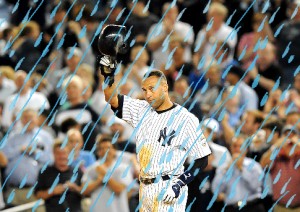
- The rain that left LA, earlier this week, has made it to New York and will dampen (if not deluge) our weekend in the City. (Thanks, LA.)
I wouldn’t mind, but I’m waiting somewhat impatiently to see the Yankee-Angels games, and I hope they won’t be rained-out. I have too much emotional investment in that series to be blottoed by RAIN!
Books &Commentary &Daily post 13 Oct 2009 07:45 am
Magoo’s Christmas
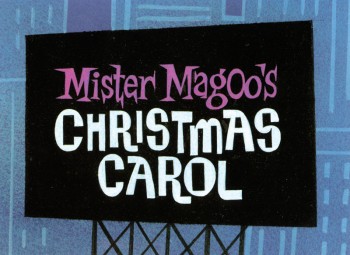
- On Tuesday, Dec 1 The Paley Center in New York will host a screening of Mr. Magoo’s Christmas Carol. After the screening there will be a panel discussion which includes the following guests:
- Darrell Van Citters, Animator and Author of Mister Magoo’s Christmas Carol: The Making ____of the First Animated Christmas Special,
- Judy Levitow, Daughter of Magoo Director Abe Levitow
- Marie Matthews, Voice of “Young Scrooge”
- Moderator: Jack Doulin, of the New York Theatre Workshop.
The program starts at 6pm and general admission is $20. All guests will receive a complimentary DVD of Mister Magoo’s Christmas Carol.
I’ll post this again as we get closer to the date, but you might want to buy tickets in advance for this special program. Hopefully you’ll have the dvd at hand to wash out the taste of the all-Jim Carrey version coming to a theater near you.
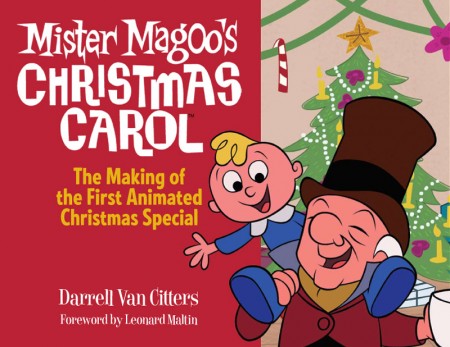 - This announcement gives me the opportunity of recommending, again, Darrel van Citters’ excellent book, Mister Magoo’s Christmas Carol: The Making of the First Animated Christmas Special. Reading this attractive book gave me new insights into the program as well as the production of animation in the relatively early era of tv production. There’s a wealth of behind-the-scenes material about the production from concept to completion.
- This announcement gives me the opportunity of recommending, again, Darrel van Citters’ excellent book, Mister Magoo’s Christmas Carol: The Making of the First Animated Christmas Special. Reading this attractive book gave me new insights into the program as well as the production of animation in the relatively early era of tv production. There’s a wealth of behind-the-scenes material about the production from concept to completion.
Some bits:
- As a fan of Jule Styne‘s work, I find it remarkable the amount of information given about this composer as well as his score for this show. Styne and Bob Merrill were writing FUNNY GIRL for Broadway at the same time, and found themselves bogged down with producton delays. They took the UPA cartoon because they thought it’d be fun and they’d be able to squeeze it in before their Broadway show got up and running again. They also thought they could make a quick buck. Of course, the music gives the show the weight it needs with solid, strong tunes. (There were also a few others asked before Styne was selected.)
Abe Levitow was directing Gay Purr-ee at the exact same time he was doing Magoo’s Christmas Carol. This presented logistic problems which are detailed here in an entertaining read.
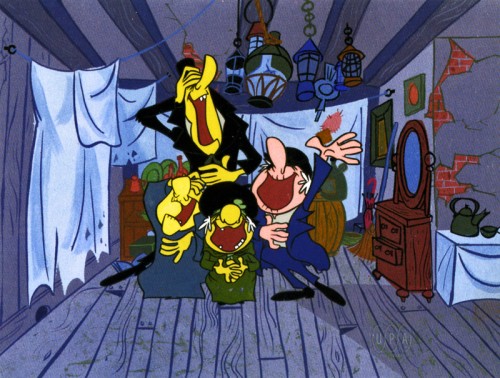
Gerard Baldwin had only two weeks to animate the “Despicables” song.
He completed the sequence, which was one of the highlights of the show, on time.
Shirley Silvey had a limited amount of time away from her work on The Bullwinkle Show. She used it to design the story board for Magoo and help in the early stages of the show’s Layouts.
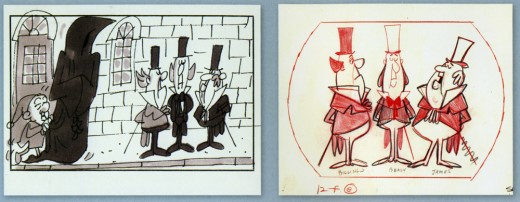
A Shirley Silvey storyboard drawing alongside a matching Layout by Sam Weiss.
It’s a good read with lots of the business side mixed in with the artistry. Darrell Van Citters is a Producer/Director/Animator by day. Consequently, the informed animation reader feels in safe hands throughout the book. He knows what rocks to turn over, and his curiosities in this film are ours. He talks about the things you want to know, and he opens up avenues you didn’t expect to see explored. Van Citters financed this book, himself; he believes in it, and you feel that from the first page. It’s a fine book.
Commentary &Daily post &SpornFilms 10 Oct 2009 08:12 am
Sendak/Poe
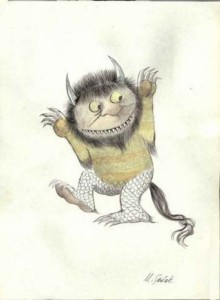 – NYC is currently celebrating Maurice Sendak. This obviously has all to do with the release of the new Spike Jonze feature based on the book, Where the Wild Things Are. The artwork, twelve drawings and two manuscript pages, will be on view in the Morgan Library‘s historic McKim building. The exhibit extends from now through Nov. 1st. (There’s a hefty admission fee – @12 – to the museum, but they also have a William Blake exhibit on display. As their catalogue reads: on display are “Blake’s most spectacular watercolors, prints, and illuminated books of poetry to dramatically underscore his genius and enduring influence.”)
– NYC is currently celebrating Maurice Sendak. This obviously has all to do with the release of the new Spike Jonze feature based on the book, Where the Wild Things Are. The artwork, twelve drawings and two manuscript pages, will be on view in the Morgan Library‘s historic McKim building. The exhibit extends from now through Nov. 1st. (There’s a hefty admission fee – @12 – to the museum, but they also have a William Blake exhibit on display. As their catalogue reads: on display are “Blake’s most spectacular watercolors, prints, and illuminated books of poetry to dramatically underscore his genius and enduring influence.”)
The Animazing Gallery is featuriing another Sendak show. On display will be more than 200 pieces by Mr. Sendak. There will also be etchings, limited editions and posters for sale.
I’m sure you’re all familiar with the site Terrible Yellow Eyes, but I thought I’d mention it in case there are those who are not. It’s a site built to post artwork by invited artists who were inspired by Sendak’s Where the Wild Things Are. There are a lot of good, creative pieces on display at this site.
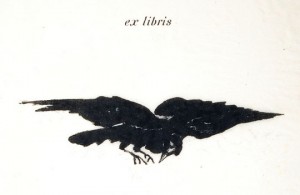 – As you all may or may not know, I’m working hard to put together an animated feature length biography of Edgar Allan Poe. I have become somewhat addicted to information about Poe and have continually sought more. Even though the script is complete and some of the voices are recorded, I’ve been planning some significant changes to the scope of the script and story. Naturally enough, I have a site dedicated to this film (Poestory.net) and infrequently update information in the production notes section.
– As you all may or may not know, I’m working hard to put together an animated feature length biography of Edgar Allan Poe. I have become somewhat addicted to information about Poe and have continually sought more. Even though the script is complete and some of the voices are recorded, I’ve been planning some significant changes to the scope of the script and story. Naturally enough, I have a site dedicated to this film (Poestory.net) and infrequently update information in the production notes section.
This is the 200th anniversary for Poe, and two interesting events have come to my attention:
. The NYTimes reported that two ceremonial burials will be held for E. A. Poe this coming Sunday to celebrate the author. Poe’s death was so peculiar that he ended up buried in a pauper’s grave, then moved to the current grave. Fewer than 10 people attended the original service. The city of Baltimore is hoping to get it right this time.
. Secondly, The Baltimore Museum of Art has just opened a show that features artwork that celebrates Poe and his stories. Lots of Manet (who did an illustrated version of The Raven – above right – in 1875), Odilon Redon and even a Robert Motherwell.
I’m seriously thinking about making a trip to Baltimore, soon.
Commentary &SpornFilms &T.Hachtman 06 Oct 2009 08:35 am
McLouvre/3DToys/Myazaki 2011-13
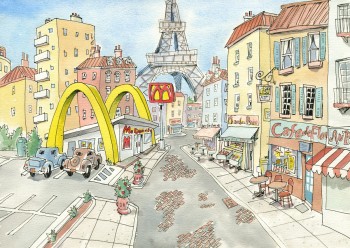 – The news that a McDonalds will be built within the Louvre is something of a shock to the system. For some reason, I would’ve thought this had happened years ago. Doing it now is somhow passé.
– The news that a McDonalds will be built within the Louvre is something of a shock to the system. For some reason, I would’ve thought this had happened years ago. Doing it now is somhow passé.
Last year we did a little short from the feature storyboard done a million years ago, based on Tom Hachtman’s comic strip Gertrude’s Follies. The segment involves Gertrude and Alice introducing Pabs (Picasso) to his first hamburger. Since our story takes place in Paris, they’re at a MacDonald’s within shooting distance of the Eiffel Tower. Had I known there would be a Mickey Dee in the Louvre, it would have been more appropriate to put it there.
Maybe we should redo the short.
- Last week Amid Amidi started several threads of a conversation about te economics of posting films on line. This was followed up by Mark Mayerson on his blog, going into contracts with some depth.
This all followed some thoughts I’d been having about a short film we did in this studio last year. I entered it into one Festival and was soon rejected. Since then I’ve been sitting on it, debating how to exploit it.
It’s the film, discussed above, the pilot for the Gerturde’s Follies film. It was just a kick making it in the studio in between a couple of paying jobs. I wouldn’t mind doing more of them and might actually go ahead with that idea. But for now, I’m making the rash decision to post the film here and now. I’m only going to keep it up for a week or so, and then I’ll replace it with some stills. But for now I’ll forego Frederator’s $50 or Cartoon Brew’s $200.
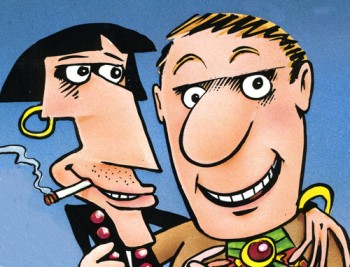
An image from the cover of Tom’s book
collecting some of the Gertrude Strips.
.
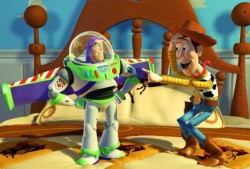 - On the NYTimes website John Lasseter talks about the “digital archeology” behind adapting Toy Story and Toy Story 2 into 3D movies. He doesn’t really say much, but you can hear his voice saying it while looking at stills from both films. (For actual information, read the accompanying article.) Lasseter sounds tired and listless, as if he were in the middle of a junket and had repeated this material a hundred times that day.
- On the NYTimes website John Lasseter talks about the “digital archeology” behind adapting Toy Story and Toy Story 2 into 3D movies. He doesn’t really say much, but you can hear his voice saying it while looking at stills from both films. (For actual information, read the accompanying article.) Lasseter sounds tired and listless, as if he were in the middle of a junket and had repeated this material a hundred times that day.
This slide-show feature on the NYTimes site often has some interesting bits to show or explain. The slide sow for Shane Acker’s 9 offered some details about the production design for the film. Similarly, for Coraline, Henry Selick takes us on a tour of shooting 3D with puppet animation. He details the differences between the real and the “other” worlds of Coraline. Lots of stills of drawings, puppets, people in process and screen shots illustrate the excellent narrative. For Pixar’s Up, Pete Doctor takes us on a backstage tour of the character development behind the film. There are lots of models and early stills of artwork as they get to the characters. Each character also has its own sound cue. This is a sophisticated talk from Pixar, one wonders why so shoddy for the 3d re-releases.
.
Daniel Thomas MacInnes writes on his The Ghibli Blog that Miyazaki is working on not one but two features: one for 2011, the other for 2013. Daniel doesn’t have titles or news about what the films are about, baut he does investigate the idea that two films would be so closely produced, back-to-back. Interesting if you’re a Miyazaki fan.
 The Shadows Dream is the latest Op Ed animation offered via the NY Times by Jeff Scher.
The Shadows Dream is the latest Op Ed animation offered via the NY Times by Jeff Scher.
The intro on the Times site reads:
“Fall’s later sunrises bring longer shadows to the morning rush hour. On any particularly sunny morning, the shadows of people in the city seem to constitute a fleeting parallel universe at our feet.”
Jeff is really on to something with this piece, and I can imagine it going a lot further than it does here. I hope he continues with these experiments. Again, Shay Lynch’s music is exceptional. (I’m curious to hear the score he wrote for Paul Fierlinger’s feature.)
Bill Peckmann &Books &Commentary 30 Sep 2009 07:47 am
Snap Crackle Pop
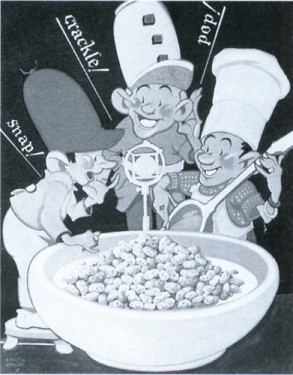
The original Snap, Crackle and Pop
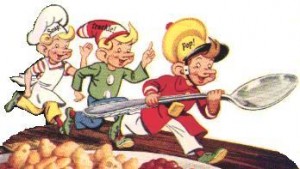 - Vernon Grant was the designer of the three elves who’ve appeared on the Rice Krispies package since 1928.
- Vernon Grant was the designer of the three elves who’ve appeared on the Rice Krispies package since 1928.
Snap, Crackle and Pop have gone through many incarnations since their debut. Their ears and noses have been reduced and softened, and their costumes have changed significantly.
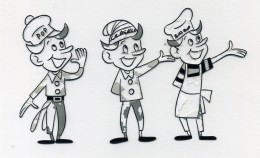

Two other variations found on liine. The left animated at Playhouse Pictures in the Fifties.
A couple of commercials can be found on YouTube. Naturally enough, the quality degenerates chronologically.
#1, #2, #3, #4, #5
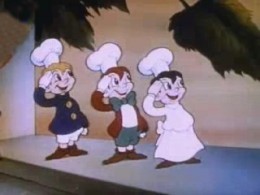 In 1939, Snap, Crackle and Pop starred in a short called Breakfast Pals. In the 1½ minute film, the three elves have to fight another three elves: Soggy, Mushy and Toughy. Ultimately, our heroes roll the bizzaro elves into a syrupy pancake and prepare Rice Krispie cereal for two boys sharing a sleep-over.
In 1939, Snap, Crackle and Pop starred in a short called Breakfast Pals. In the 1½ minute film, the three elves have to fight another three elves: Soggy, Mushy and Toughy. Ultimately, our heroes roll the bizzaro elves into a syrupy pancake and prepare Rice Krispie cereal for two boys sharing a sleep-over.
The film was made by Cartoon Films Ltd. This was the last incarnation of Ub Iweerks’ own studio. He was, at the time, making some short films for Columbia.
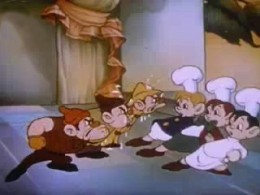
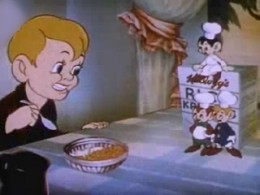
Soggy, Mushy and Toughy fight Snap Crackle & Pop
In 1939, the Kelloggs Corporation sent this letter which talks of other illustrations by Vernon Grant. Mother Goose rhymes were added to the package backs and became very popular. Kellogs sought to publish them.
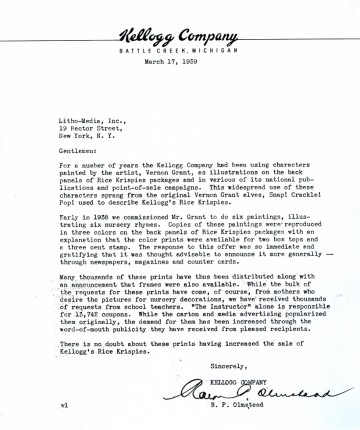
(Click any image to enlarge.)
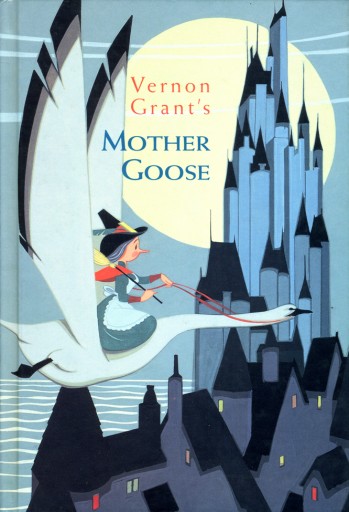
This is the subsequent book, which became
quite successful and is still available.
I’ll post the illustrations for the book tomorrow.
The letter and book are courtesy of Bill Peckmann to whom many thanks are offered.
Books &Commentary &walk cycle 12 Sep 2009 07:40 am
Cartooning
- When I was a kid, there were few resources one could turn to for information about animation and the process of making these films. Before computers, information was somewhat more difficult to acquire.
I couldn’t afford many books on the subject. Of course, I owned the Preston Blair book and that other Walter T. Foster book about Making Animated Cartoons (the one that wasn’t drawn very well and included animation examples that just didn’t work.) My treasure was the 1958 Bob Thomas book, The Art of Animation, with its technicolor focus on Sleeping Beauty.
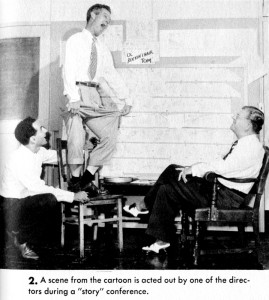 I also clipped every magazine/newspaper article or image I could find about cartoons and saved it in a homemade scrapbook. It would be years before I came upon Mike Barrier‘s Funnyworld Magazine or any other mag, for that matter, that focused exclusively on animation or cartooning.
I also clipped every magazine/newspaper article or image I could find about cartoons and saved it in a homemade scrapbook. It would be years before I came upon Mike Barrier‘s Funnyworld Magazine or any other mag, for that matter, that focused exclusively on animation or cartooning.
There were other books, and I went to the library to check them out monthly. I treasured that library copy of Robert Field‘s The Art of Walt Disney that I read over and over again. I appreciated Nat Falk‘s How to Make Animated Cartoons.
There was one book The Complete Guide to Cartooning by Gene Byrnes that had a chapter on MGM cartoons. This book had some of the greatest photos in it. Animators, inkers, directors, cels and sound effects. The pictures were great in that forties kinda way that just had me drooling animation when I looked at it. (It was published in Jan, 1950.)
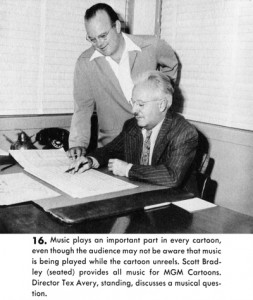 This came to me years ago when I found the animation section of this book on line. I haven’t been able to locate the site again; if I do, I’ll post the link or scan the section myself to post.
This came to me years ago when I found the animation section of this book on line. I haven’t been able to locate the site again; if I do, I’ll post the link or scan the section myself to post.
It came again recently when friend, Tom Hachtman, visited and brought a copy he owned to see if I knew about it. Of course, opening the whole book was like going home again after dozens of years. I knew every page intimately.
Two pages that stood out followed the MGM section and had the same effect within the book of seeing a Terrytoons cartoon after seeing one from MGM. Low rent. The pages look like left overs from Nat Falk’s book (and may, in fact, have been part of one of his books.)
However it amused me to look them over and actually run the peculiar walk cycle through AfterEffects to watch the motion. There are no registration marks, so I had to guess. (I didn’t take a lot of time with this, believe me.)
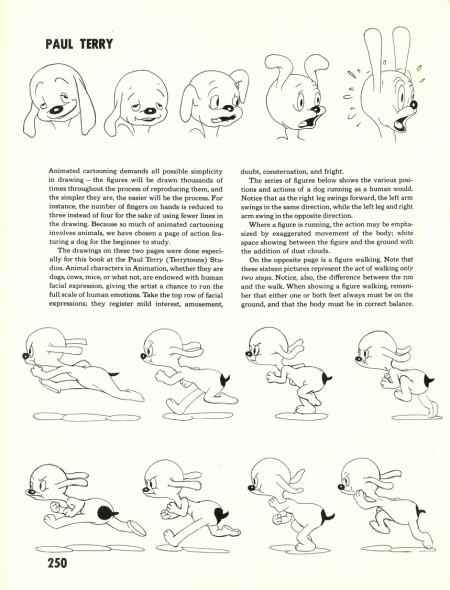
(Click any image to enlarge.)
.
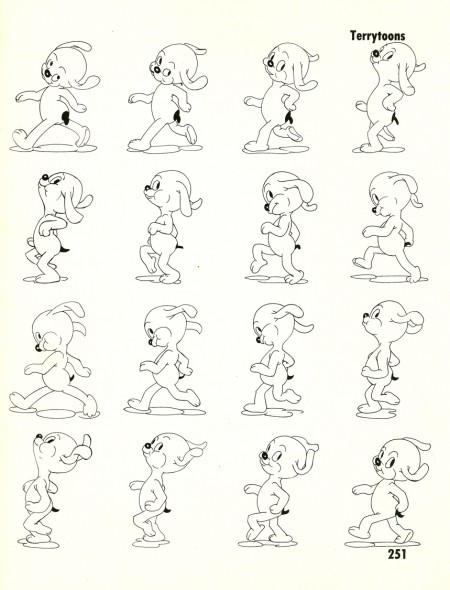
Here’s the QT of the odd pupwalk:
Pupwalk on two’s
I’m not sure who animated this – my guess Connie Rasinski
Click left side of the black bar to play.
Right side to watch single frame.
